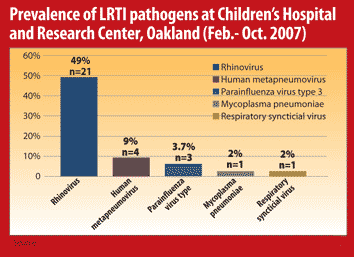Rhinovirus associated with more severe lower respiratory tract infections than previously believed
Researchers identified rhinovirus as the predominant infectious agent among patients admitted to the pediatric intensive care unit who presented with clinical symptoms consistent with lower respiratory tract infection.
Specimens from 43 pediatric ICU patients admitted to the Children’s Hospital and Research Center in Oakland between February 21 and October 31, 2007, were tested at the California Department of Public Health Viral and Rickettsial Disease Laboratory using polymerase chain reaction assay. Rhinovirus was identified in 21 of the 30 cases (49%) that had positive findings, followed by four cases of human metapneumovirus (9%), three cases of parainfluenza virus type 3 (7%) and one case each of respiratory syncytial virus and Mycoplasma pneumoniae (2% each).

“Molecular characterization identified the involvement of multiple strains of rhinovirus, suggesting that the rhinovirus infections in this particular pediatric ICU were the result of sporadic community acquisition rather than specific outbreaks or sustained nosocomial transmission,” Louie and colleagues wrote in the study.
Further review of medical records and laboratory characterization for the cases with rhinovirus revealed the following:
- The most frequent admission diagnoses were pneumonia (n=10), asthma exacerbation (n=4) and bronchiolitis (n=3).
- Common clinical characteristics included cough (n=15), wheezing (n=11) and fever (n=10).
- Eighteen patients (86%) had abnormal chest radiographs and 12 (57%) required mechanical ventilation.
- Ten patients (47%) were coinfected with another bacterial or viral agent.
“Further study of the pathogenic role of this virus, and the identification of particular genotypes that may be associated with more severe clinical presentations, is merited,” the researchers wrote.
Louie JK. Pediatr Infect Dis J. 2009;doi:10.1097/INF.0b013e31818ffc1b.
